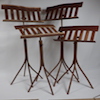I have used constuction lumber at 20% moisture for furniture before and I try not to do that now. 20% is too high. But I've never had an issue with wood down around 10% moisture. It might get a little drier or wetter after you finish the project but the piece should be designed to accomidate that (at 20% it will definitely get drier and may warp or split as it does).
I do not acclimate wood I buy. I do like to do my initial cutting leaving the pieces a little oversize, however. The reason for that is the wood sometimes moves some when you cut it down so it's best to leave it oversize so you can flatten or straighten it again after it settles for a few days - if you can take the time. But acclimation doesn't make sense to me because the moisture level in my shop is rarely the same as the moisture level in my house and both change during the year. So how does it help anything to let the wood settle at the shop moisture? The piece has to be designed to accomidate the future moisture changes anyway. You should be talking about small changes in moisture.




 Reply With Quote
Reply With Quote


